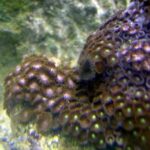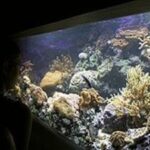Coral reefs, created by mostly corals and algae, are some of the most extravagant, stunning, massive communities found through out the world in the waters of the four oceans. Warm and clear water attracts an assortment of organisms that inhabit these coral reefs. After so many organisms make their home, they have created an ecosystem. Coral reefs contain a bunch of diverse and different types of species living within them. With all of these species, it is comparable to a whole other world, yet it is under the sea. With each diverse organism that inhibits these coral reefs, each of them offers something a little bit different to the coral reef. With different types of coral reefs, no two of them are the same.
Corals and algae are not the only organisms that help to create the coral reefs. Though corals are the head of the reef building process, there are other organisms that help to create the reefs for example, coralline algae. While some organisms have larger roles than others, some organisms help in the littlest way, like sea urchins and parrotfish, in the building of the coral reefs. Most all of the corals that build these reefs contain zooxanthellae. In which, they “help the corals make their calcium carbonate skeletons” (Castro, p.308). Although there are some corals that do not contain zooxanthellae, in which are called Ahermatypic Corals. Meaning they do not contain zooxanthellae, disabling their ability to help in the reef building process.
There is a great decline in the health of coral reefs due to all of the pollution that the coral reefs are facing. The pollution in coral reefs can be caused in many different ways. Globally, coral reefs are changing as a result of widespread impacts of both human use and ‘natural’ influences of global climate dynamics” (Field, p.55). Human interactions such as mining, over fishing, construction, and disruption, aid in the destruction the coral reefs. Toxic materials, coral bleaching, sedimentation, over grown seaweed and harmful algae, crown-of-thorns starfish, and nutrients in great quantities are also harmful to these coral reefs. These make up the natural causes of pollution in coral reefs. With two different stress causing threats, humans and nature, they are impacting the coral reefs, also, they are affecting the coral reefs in great quantities, and it is going to continue on declining.
Humans play a pretty large role in the deterioration of the coral reefs. In which, this can be avoided. With humans discarding so many materials, whether safe or harmful, decomposable or not, without thinking where they may go or how it may affect the environment, it aids in the pollution of the oceans. More so, since coral reefs are living in the oceans, it affects them.
Coral reefs, with their astonishing view and attractive sights, are a major tourist attraction. With all of the tourists coming to view the coral reefs, it can cause major problems. To see some of these coral reefs, you have to physically get into the water. This is accomplished by boats, in which the anchor or propeller can disturb the environment of the coral reef, or by physically going into the water around the coral reef yourself. In which, some of the tourists fish in the reefs, and some tourists even scuba dive in them. With human to organism interaction, humans are disrupting the ecosystem of these coral reefs.
Mining limestone, oil and other materials destroy coral reefs. Since these reefs are made up from limestone producing organisms, it is a great place for humans to mine these materials. When humans mine in coral reefs, they are letting harmful chemical into the water. Also, they are disturbing the surrounds of the location in which they are mining at.
Another type of pollution that humans and nature contribute to the pollution scale is low concentrations of pesticides and other harmful chemicals and high concentrations of nutrients. These can be harmful if in great quantities. “Excess nutrients, including dissolved nitrogen and phosphorus from sewage, wastewater, and fertilizers, promote the growth of algae that compete with juvenile and adult corals for space on benthic reef surfaces” (Pollution). All water leads to the estuaries, where salt water and fresh water meet, then out into the ocean. Resulting in the material that is contaminated dispersing out into the ocean. So if a river is polluted, it will then eventually affect the coral reefs. “It is estimated that 10,000 tonnes of phosphorus and 100,000 tonnes of nitrogen each year are washed from the land into the waters of the Great Barrier Reef” (Information for Action).
There is a large variety of natural causes that aid in the deterioration of coral reefs. “Some are natural stresses, such as hurricanes, cyclones, typhoons, earthquakes, or plagues of coral-eating predators like the crown of thorns starfish, about which we can do little” (Why Are Coral Reefs Dying?). With so many different factors that are playing a role in this horrifying scene, all we can do is let nature take it’s course. “World-wide episodes of coral ‘bleaching,’ mass mortalities of reef-dwelling organisms, and declining abundances of coral and other reef species” (Reaka-Kudla, p.84). Coral bleaching is the ejection of zooxanthellae from the coral leaving the coral unable to reproduce and later on, unable to survive. With natural causes helping in the destruction of the coral reefs, there is nothing that can really be done to save them.
Coral predation is something that is always going to be there. It is how the ecosystem flows. Different organisms feed and graze on the corals and algae that occupy the coral reefs. For example, the crown-of-thorns starfish is a living invertebrate that in comes and goes as it pleases in coral reefs. These starfish are a predator to the coral, and eat the coral polyps. In mass amounts, these crown-of-thorns starfish can affect the coral reef negatively. Although there have been many attempts to try and stop the crown-of-thorns starfish, most of the attempts were unsuccessful.
Coral predation is something that is always going to be there. The fish that eat the coral polyps help to control the growth of the corals. “If it were not for the fish, this fast-growing coral would probably have dominated other corals in the bay” (Castro, p.327). Although some of the organisms that feed on the coral, are actually helping the coral reef instead of harming them, such as just eating the polyps off of the corals. Grazing organisms, like damselfish and crustaceans, help to control the growth of algae and seaweed that, like coral, may take over the reef.
With so many different pollution stresses affecting these coral reefs, there are only a select few ways to help prevent these different pollution methods in coral reefs. But some of the solutions are harder to accomplish than others. Such as setting boundaries of what can and cannot be done, as well as regulation on fishing and for humans to stop polluting the oceans. Although a lot of the natural causes to pollution in coral reefs can not be regulated, if humans stop their pollution, maybe coral reefs will begin to further expand.
Works Cited
Castro, Peter, and Michael E. Huber. Marine Biology. 8th ed. New York: McGraw-Hill, 2010. Print.
Field, John G., Gotthilf Hempel, and Colin P. Summerhayes. Oceans 2020: Science, Trends, and the Challenge of Sustainability. Washington: Island, 2002. Print.
“Information for Action.” Conservation, Biodiversity Sustainability Environment Issues, Automated Lobbying Database at. Web. 01 Mar. 2012.
“Pollution.” NOAA’s Coral Reef Conservation Program:. Web. 01 Mar. 2012
Reaka-Kudla, Marjorie L., Don E. Wilson, and Edward O. Wilson. Biodiversity II: Understanding and Protecting Our Biological Resources. Washington, D.C.: Joseph Henry, 1997. Print.
“Why Are Coral Reefs Dying?” Global Coral Reef Alliance. Web. 01 Mar. 2012.



